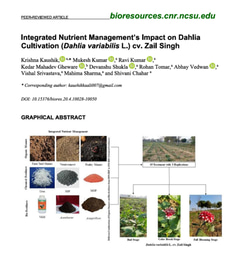Lung involvement in rheumatoid arthritis: what do we know?
Published in Public Health
Rheumatoid arthritis (RA) is a highly prevalent heterogeneous group of immune-mediated inflammatory diseases with chronic and multisystemic physiopathogenesis involving several organs. Interstitial pneumonia has emerged as the most prevalent manifestation, affecting up to 60% of patients and, in some cases, preceding joint symptoms. The effectiveness of treatments varies, with specific disease-modifying antirheumatic drugs (DMARDs) showing potential for controlling pulmonary symptoms. Early diagnosis and tailored treatment strategies are crucial for the effective management of RA-related pulmonary diseases.
RA can affect all compartments of the thorax, including the pulmonary parenchyma, large and small airways, pleura, and, less frequently, vasculature. Lung involvement typically occurs approximately five years after the diagnosis of RA, and few respiratory symptoms may precede the onset of joint symptoms.
Interstitial lung disease (ILD) is the most common manifestation of pulmonary involvement, with a prevalence of up to 80% reported via biopsy. Some cases may progress to pulmonary fibrosis and subsequent respiratory insufficiency, with implications for disease prognosis. Unfortunately, the incidence of ILD is underestimated, especially in the early stages of subclinical disease. Other pulmonary manifestations include airway involvement, pleural involvement, and rheumatoid pulmonary nodules. The pulmonary toxicity caused by drugs used to treat RA itself, including DMARDs, whether synthetic, or biological immunomodulators or so-called small molecules, is highly relevant. Synthetic drugs, mainly methotrexate (MTX), sulfasalazine (SSZ) and leflunomide (LFN), have been implicated in the onset of respiratory manifestations. The use of immunobiological therapies, such as tumor necrosis factor inhibitors (anti-TNF), has also been associated with the development or exacerbation of ILD in patients with RA.
With more sophisticated radiological techniques, such as high-resolution computed tomography of the chest (HRCT), diagnosing pulmonary involvement in RA is more efficient, with tomographic findings predominating in approximately 55% of cases. HRCT identified interstitial pulmonary abnormalities and small airway involvement, most often in subclinical disease. The most common tomographic findings are the presence of pulmonary infiltrates with a predominance of ground-glass changes and septal and subpleural thickening, usually to a small extent.
Although RA is more common in women, ILD associated with RA (RA–ILD) occurs more frequently in men in the sixth decade of life. Some risk factors for developing RA–ILD are male sex, advanced age, smoking, high titers of antibodies to RF and/or anti-CCP, RA disease activity, decreased functional status, and the presence of other nonpulmonary extra-articular diseases, such as subcutaneous rheumatoid nodules. Genetic risk factors have also been identified in RA–ILD, including the MUC5B promoter variant particularly associated with the usual interstitial pneumonia (UIP) pattern and various rare variants in telomerase. Individuals with RA are nine times more likely to develop ILD than the general population. Only 10% of patients with RA–ILD exhibit respiratory symptoms.
Interstitial lung disease comprises a spectrum of histological types with different clinical and radiological patterns. There is a vast spectrum of pulmonary histopathology in ILD patients with RA, with classes according to the American Thoracic Society/European Respiratory Society classification system for idiopathic interstitial pneumonia. The most common histopathological types are usual interstitial pneumonia (UIP) , nonspecific interstitial pneumonia (NSIP), and organizing pneumonia (OP). Other patterns of pulmonary involvement in RA include macrophage interstitial pneumonia (desquamative), diffuse alveolar damage, and lymphocytic interstitial pneumonia.
Once the diagnosis of RA has been established, the therapeutic approach is defined based on the joint symptoms. Unlike systemic sclerosis, where lung involvement is strategically investigated before treatment is defined, screening strategies for RA–ILD are not implemented unless respiratory symptoms are present. Because there are no established screening strategies, many of these approaches have been extrapolated to treating scleroderma or interstitial pulmonary fibrosis (IPF). Pulmonary function tests and HRCT can be used as diagnostic measures, especially in patients with risk factors such as smoking and advanced age.
Because there is no completely established therapeutic approach, decisions should be based on the benefits and clinical presentation of each patient. In asymptomatic patients with nonprogressive ILD, treatment is conservative. There is no defined therapeutic approach and patients with UIP respond poorly to treatment. Patients with NSIP and OP patterns may respond more favorably to immunosuppressants; however, some patients present with mixed or unclassifiable patterns on HRCT, making disease progression and therapeutic response unpredictable.
Follow the Topic
-
Discover Medicine

This is a fully open access, peer-reviewed journal that supports multidisciplinary research and policy developments across the fields of medical and clinical science.
Related Collections
With Collections, you can get published faster and increase your visibility.
Metabolic Wellness: Addressing the Health Prevention and Management of Obesity and Type 2 Diabetes
Obesity and type 2 diabetes mellitus (T2DM) represent two of the most pressing and interlinked public health challenges of the 21st century. With escalating global prevalence, these conditions are no longer confined to affluent nations, but are rapidly rising in developing countries, driven by sedentary lifestyles, dietary transitions, environmental factors, and genetic predispositions. This Collection aims to provide a comprehensive and multidisciplinary examination of the complex biological, clinical, epidemiological, and socio-environmental mechanisms that underpin the obesity-diabetes nexus.
We invite contributions that critically explore the pathophysiological pathways linking adiposity to insulin resistance, including the roles of chronic low-grade inflammation, adipokine signaling, mitochondrial dysfunction, and gut microbiota. Research addressing genetic and epigenetic factors, pediatric and gestational diabetes, ethnic and gender disparities, and emerging biomarkers are particularly encouraged. Furthermore, we seek discussions on intervention strategies encompassing pharmacological treatments, nutritional modulation, lifestyle interventions, and public health policy frameworks that target obesity and T2DM prevention.
This Collection will serve as an essential reference for endocrinologists, diabetologists, obesity researchers, public health professionals, nutritionists, molecular biologists, and policymakers. By integrating global perspectives and cutting-edge research, it aspires to advance understanding and foster collaborative efforts toward mitigating this dual epidemic. Prospective authors are encouraged to contribute original chapters, clinical insights, or region-specific case studies that align with the Collection’s central theme such as:
1. Gut Microbiota and the Obesity-Diabetes Axis
2. Oxidative Stress and Mitochondrial Dysfunction in Obesity and T2DM
3. Epigenetic Modifications in Obesity and Glucose Metabolism Disorders
4. Artificial Intelligence and Digital Health Tools in Managing Obesity and Diabetes
5. Community-Based Interventions for Reducing Obesity and Diabetes Prevalence
Keywords: Obesity, BMI, Diabetes, Pathophysiology, Metabolic Syndrome, Cardiovascular diseases
Publishing Model: Open Access
Deadline: Mar 31, 2026
New Trends in Clinical Laboratory Medicine
The main purpose of the issue is to explore novelties in clinical biochemistry and laboratory medicine. The issue aims to cover different emerging topic.
One significant trend in clinical laboratory medicine is the use of automation, machine learning and artificial intelligence (AI) to improve laboratory workflows, reduce turnaround times, and enhance the accuracy of laboratory test results. Laboratories are adopting automated systems that can perform sample processing, analysis, and result reporting with minimal human intervention, resulting in faster and more efficient testing processes.
Furthermore, there has been a growing interest in using machine learning algorithms to analyze large amounts of data generated by clinical biochemistry tests. These techniques can also help to identify new biomarkers, develop more accurate diagnostic tools, and improve treatment outcomes.
The development of new biomarkers for disease diagnosis and monitoring can improve disease detection and treatment.
In this context, metabolomics can be applied to biomarker discovery, drug development and personalized medicine.
Another ongoing trend in clinical biochemistry is the increased use of personalized medicine. This approach involves tailoring medical treatment to the individual patient's unique characteristics, such as their genetics and metabolism. Advances in genomic sequencing and other technologies have made it easier to identify specific biomarkers and genetic mutations that can be targeted with personalized therapies. Moreover, new rapid diagnostic techniques are requested to tackle problems such as antibiotic resistance. Overuse or misuse of antibiotics recommended by physicians/self-medication at the time of infection has meant that drug-resistant pathogens have become a major healthcare issue, with millions of reported cases every year. Rapid diagnostics plays a pivotal role in the treatment of bacterial infection. For the timely treatment of patients, a rapid antimicrobial susceptibility test (AST) is urgently needed. Advanced diagnostics would allow clinicians to more quickly determine the most effective treatment, reduce the nonspecific use of broad-spectrum antimicrobials, and facilitate enrollment in new antibiotic treatments. A rise in antibiotic resistance is a certainty, therefore, we must develop technologies that will permit rapid AST (within few hours) and are non-invasive (saliva- or urine-based) or minimally invasive. At the same time, Point-of-Care Testing (POCT) has gained significant importance in healthcare due to its potential to provide rapid and accurate diagnostic results directly at the patient's bedside or in a non-laboratory setting. POCT indeed offer rapid, accessible, and versatile diagnostic capabilities, allowing for enhanced patient management, reduced turnaround time, and improved healthcare outcomes. POCT has the potential to revolutionize the way diagnostic testing is performed and integrated into healthcare systems.
SUMMARY
Clinical Biochemistry and Laboratory Medicine have a central role in achieving a quick and correct diagnosis. This Special Issue plans to give an overview of the most recent advances in the field.
This special issue is aimed at providing innovative contribution on new trends and advances on clinical biochemistry related to different topics.
Potential topics include, but are not limited to:
Automated systems
Biomarkers
Metabolomics, Volatolomics
Machine learning, Artifical Intelligence
Rapid diagnostics
POCT
Keywords: POCT, Biomarkers, Metabolomics, Volatolomics, Machine learning, Artifical Intelligence, Rapid diagnostics, Automated systems
Publishing Model: Open Access
Deadline: Jan 30, 2026




Please sign in or register for FREE
If you are a registered user on Research Communities by Springer Nature, please sign in